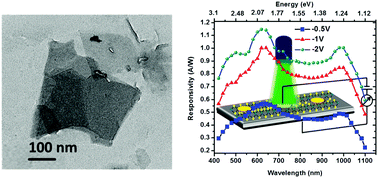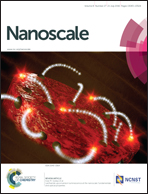Novel silicon compatible p-WS2 2D/3D heterojunction devices exhibiting broadband photoresponse and superior detectivity
Abstract
We report for the first time, the fabrication of novel two-dimensional (2D) p-WS2/n-Si vertical heterostructures with superior junction and photoresponse characteristics. Few layer WS2 has been synthesized by a lithium-ion intercalation technique in hexane and coated on Si substrates for realization of CMOS compatible devices. Atomic force microscopy and Raman spectroscopy have been used to confirm the 2D nature of WS2 layers. Sharp band-edge absorption and emission peaks have indicated the formation of mono-to-few-layers thick direct band gap WS2 films. The electrical and optical responses of the heterostructures have exhibited superior properties revealing the formation of an abrupt heterojunction. The fabricated photodetector device depicts a peak responsivity of 1.11 A W−1 at −2 V with a broadband spectral response of 400–1100 nm and a moderate photo-to-dark current ratio of ∼103. The optical switching characteristics have been studied as a function of applied bias and illuminated power density. A comparative study of the reported results on 2D transition metal chalcogenides indicates the superior characteristics of WS2/n-Si heterostructures for future photonic devices.


 Please wait while we load your content...
Please wait while we load your content...